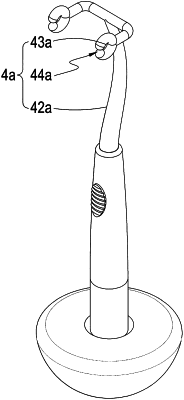| CPC A47K 1/09 (2013.01) [A46B 5/0095 (2013.01); A61C 15/048 (2013.01); A46B 2200/1066 (2013.01)] | 4 Claims |

|
1. An anti-tipping exchanging structure of an oral hygiene instrument, the oral hygiene instrument comprising:
a handle member;
a base member, the base member comprising a weight element, a circular curved section, and a base engaging section, the circular curved section being formed on one side of the weight element, the base engaging section being formed on one side of the weight element that is opposite to the circular curved section, the base engaging section engageable and combinable with an end of the handle member;
a handle engaging portion, the handle engaging portion being provided on the handle member; and
a hygiene piece, the hygiene piece being provided with a mutual engaging section that allows the hygiene piece to be set in engagement with and mounted to the handle engaging portion through the mutual engaging section by means of tight fitting therebetween, the hygiene piece including a first rod, a plurality of holed sections, and a plurality of detaching sections, the holed sections being formed on the first rod, the first rod comprising a curved portion to which the holed sections are connected, the detaching sections being formed in a side wall of the holed sections, wherein each of the plurality of holed sections includes a circular hole and the side wall includes a circumferential wall circumferentially extending around the circular hole, and each of the plurality of detaching sections includes an opening formed in the circumferential wall of the circular hole, and wherein the plurality of holed sections are arranged such that the circular holes of the plurality of holed sections have centers that are in alignment with each other along a common central axis and the openings of the plurality of detaching sections are in alignment with each other in a direction parallel with the common central axis.
|